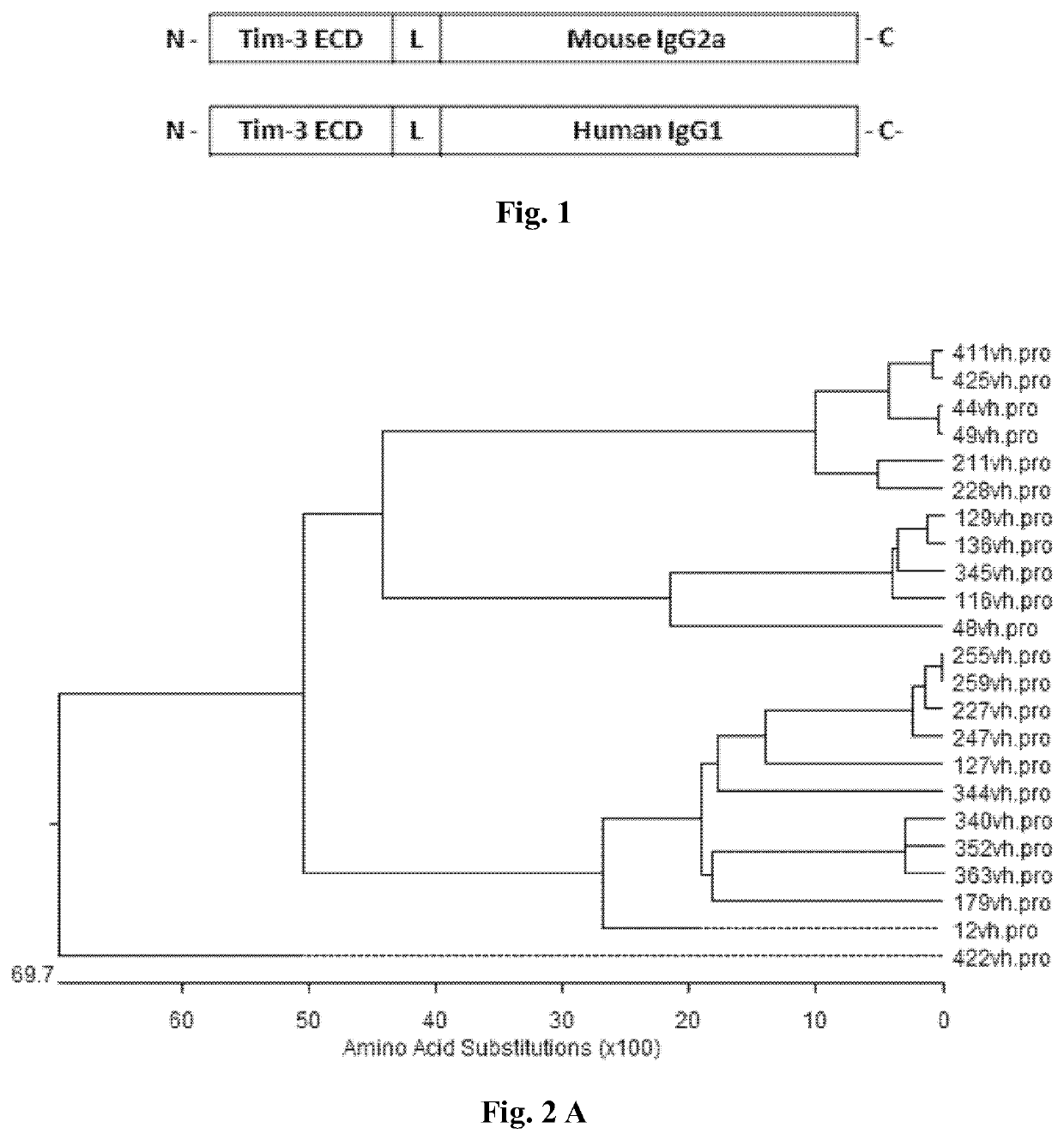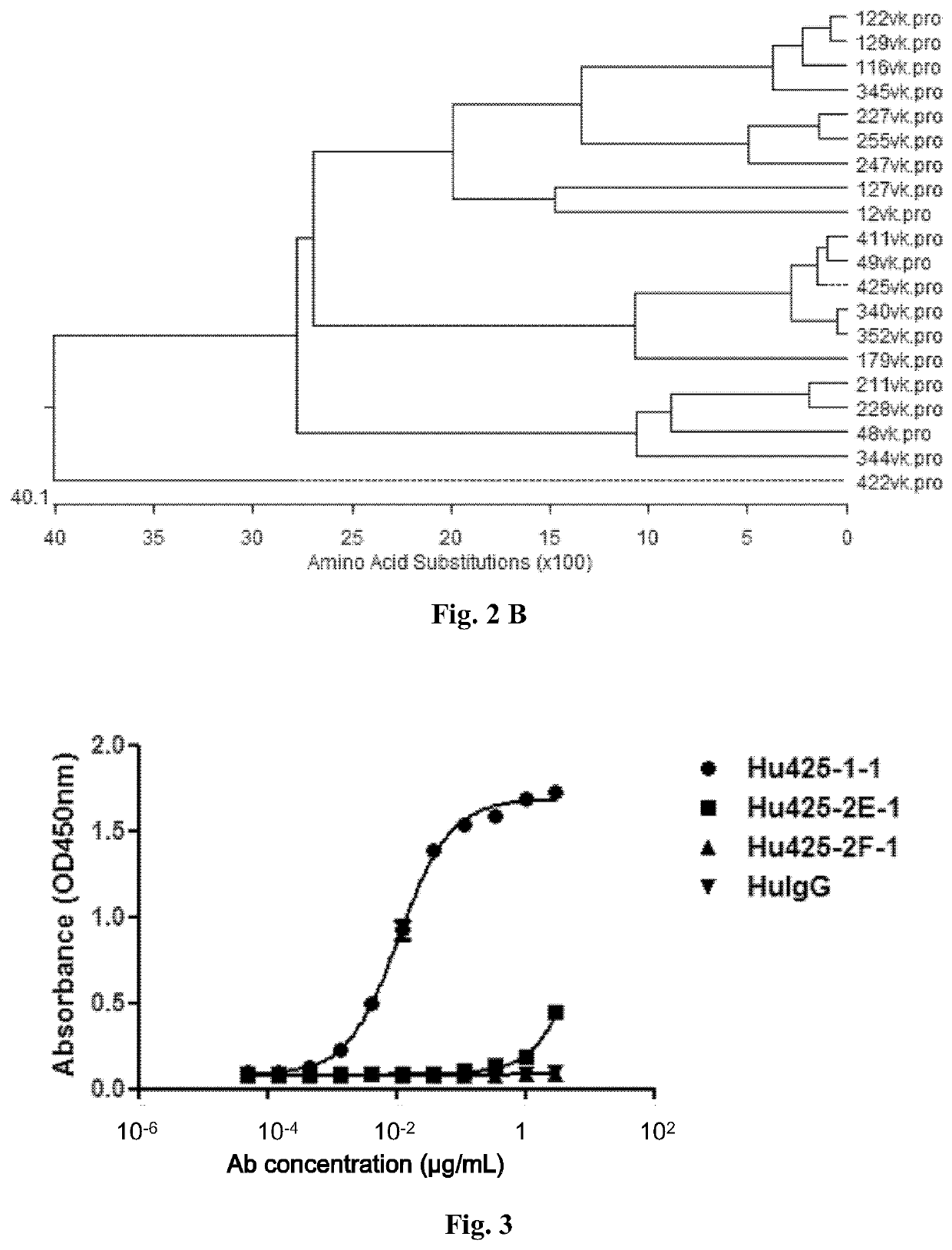Anti-Tim-3 antibodies and use thereof
a technology of anti-tim-3 antibodies and antibodies, applied in the field of anti-tim-3 antibodies, can solve the problems of poor survival outcome of patients, and achieve the effects of reducing tumor growth, enhancing immunity, and high degree of similarity
- Summary
- Abstract
- Description
- Claims
- Application Information
AI Technical Summary
Benefits of technology
Problems solved by technology
Method used
Image
Examples
example
Example 1. Generation of Anti-Tim-3 Monoclonal Antibodies
[0112]A number of murine anti-Tim-3 monoclonal antibodies (mAbs) were generated based on conventional hybridoma technology (de StGroth and Sheidegger, 1980, J Immunol Methods 35:1; Mechetner, 2007, Methods Mol Biol 378:1). The mAbs with high binding activity in enzyme-linked immunosorbent assay (ELISA) and fluorescence-activated cell sorting (FACS) assay were selected for further characterization.
[0113]Tim-3 Recombinant Proteins for Immunization and Binding Assays
[0114]The cDNA coding for the full-length human Tim-3 (SEQ ID NO. 1) was synthesized based on the GenBank sequence (Accession No: AF450242.1). The coding region of extracellular domain (ECD) consisting of amino acid (AA) 1-202 of Tim-3 (SEQ ID NO. 2) was PCR-amplified, and cloned into a pcDNA3.1-based expression vector (Invitrogen, Carlsbad, Calif., USA) with C-terminus fused either to the Fc region of mouse IgG2a (GenBank Accession No: CAC20702) or to the Fc region o...
example 2
nd Sequence Analysis of Tim-3 Antibodies
[0125]Murine hybridoma cells were harvested to prepare total RNAs using Ultrapure RNA kit (Cat. No.: 74104, QIAGEN, Germany) based on the manufacturer's protocol. The 1st strand cDNAs were synthesized using a cDNA synthesis kit from Invitrogen (Cat. No.: 18080-051) and PCR amplification of Vh and Vk genes of murine mAbs was performed using a PCR kit (Cat. No.: CW0686, CWBio, Beijing, China). The oligo primers used for antibody cDNAs cloning of heavy chain variable region (Vh) and kappa light chain variable region (Vk) were synthesized based on the sequences reported previously (Brocks et al., 2001 Mol Med 7:461). PCR products were then subcloned into the pEASY-Blunt cloning vector (Cat. No.: CB101-02, TransGen, China) and sequenced. The amino acid sequences of Vh and Vk regions were deduced from the DNA sequencing results.
[0126]The murine mAbs were analyzed by comparing sequence homology and grouped based on sequence similarity (FIG. 2). Compl...
example 3
Determination of Purified Murine Anti-Tim-3 Antibodies by SPR
[0129]The Tim-3 antibodies with high binding activities in ELISA and FACS, as well as with potent functional activities in the cell-based assays (described in Examples 7 and 8) were characterized for their binding kinetics by SPR assays using BIAcore™ T-200 (GE Life Sciences). Briefly, anti-human IgG antibody was immobilized on an activated CM5 biosensor chip (Cat. No.: BR100530, GE Life Sciences). Human Fc-tagged Tim-3 IgV domain was flowed over the chip surface and captured by anti-human IgG antibody. Then a serial dilution (0.36 nM to 90 nM) of purified murine antibodies were flowed over the chip surface and changes in surface plasmon resonance signals were analyzed to calculate the association rates (kon) and dissociation rates (koff) by using the one-to-one Langmuir binding model (BIA Evaluation Software, GE Life Sciences). The equilibrium dissociation constant (KD) was calculated as the ratio koff / kon. The binding af...
PUM
| Property | Measurement | Unit |
|---|---|---|
| dissociation constant | aaaaa | aaaaa |
| dissociation constant | aaaaa | aaaaa |
| size | aaaaa | aaaaa |
Abstract
Description
Claims
Application Information
 Login to View More
Login to View More - R&D
- Intellectual Property
- Life Sciences
- Materials
- Tech Scout
- Unparalleled Data Quality
- Higher Quality Content
- 60% Fewer Hallucinations
Browse by: Latest US Patents, China's latest patents, Technical Efficacy Thesaurus, Application Domain, Technology Topic, Popular Technical Reports.
© 2025 PatSnap. All rights reserved.Legal|Privacy policy|Modern Slavery Act Transparency Statement|Sitemap|About US| Contact US: help@patsnap.com



